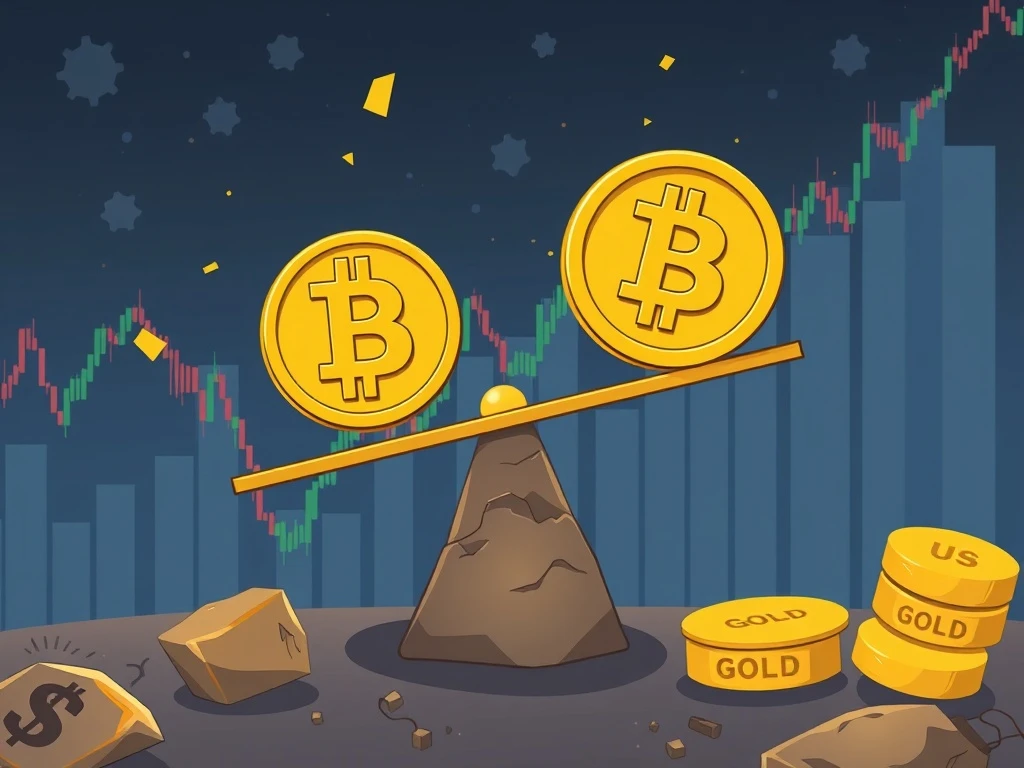Bitcoin Price Volatility: Crucial Test Amid US Payrolls Miss and Gold’s Record High

Bitcoin price often reacts unpredictably to major economic news. Recently, the crypto market witnessed a puzzling scenario. Despite a significant US payrolls miss, Bitcoin’s price failed to rally. This unexpected behavior has left many investors questioning current market dynamics. Understanding these shifts is crucial for any serious crypto market analysis.
US Payrolls Data: A Significant Miss Shakes Markets
The latest US jobs report revealed a substantial miss. August nonfarm payrolls (NFP) added only 22,000 jobs. This figure fell far short of the anticipated 75,000. Such a significant miss typically signals a weakening labor market. Consequently, the US dollar’s strength plummeted. This economic data often influences asset markets globally. Investors closely monitor NFP reports for signs of economic health. A weak report usually suggests the Federal Reserve might ease monetary policy. Indeed, the August print marks the second-lowest jobs report number since July 2021. The labor market appears to be rapidly deteriorating. Furthermore, previous months’ job numbers were also revised down, painting a bleaker picture. Adam Kobeissi, founder of The Kobeissi Letter, noted that the US economy lost 357,000 full-time jobs in August alone. This suggests the labor market is far worse than many initially thought.
Fed Rate Cut Expectations Solidify
This disappointing US payrolls data immediately fueled speculation. Market participants now largely expect the Federal Reserve to implement interest rate cuts. The CME Group’s FedWatch Tool confirms this high probability. Specifically, a rate cut at the September 17 meeting seems highly likely. Lower interest rates generally make risk assets more attractive. This is because borrowing costs decrease. Furthermore, traditional savings often offer lower returns. Therefore, many expected a positive impact on Bitcoin. This macroeconomic tailwind typically provides a boost for growth-oriented investments. Yet, Bitcoin’s reaction diverged sharply from these expectations. The increased likelihood of rate cuts usually signals a more accommodative monetary environment. This environment often encourages investment in riskier assets, including cryptocurrencies.
Gold’s Record High: A Striking Contrast
In stark contrast to Bitcoin’s performance, gold soared. The precious metal achieved yet another all-time high. Gold often acts as a safe haven asset during economic uncertainty. Its surge underscores investor concerns about the economy. While the US dollar weakened, gold’s value increased significantly. This divergence highlights different market reactions to the same economic news. Traditionally, Bitcoin has sometimes been dubbed ‘digital gold.’ However, its recent action tells a different story. Gold’s rally reflects a clear flight to safety. Investors sought protection from economic instability. This move indicates a preference for traditional stores of value. The sustained strength in gold prices contrasts sharply with Bitcoin’s struggle for momentum.
Bitcoin Price Volatility: Gains Erased Despite Macro Tailwinds
Following the US payrolls data, Bitcoin price showed unsettling volatility. Initially, BTC/USD surged to new September highs, reaching $113,400. However, this gain was short-lived. The price quickly reversed course, dropping almost $3,000 in just one hour. It effectively erased all its earlier advances. This rapid decline pushed Bitcoin below the $111,000 mark. Such price swings can test investor confidence. Bulls, unfortunately, found themselves nowhere to be seen. The market displayed a noticeable lack of sustained buying pressure. This behavior puzzled many analysts. Normally, news suggesting easier monetary policy would boost Bitcoin. Yet, the asset failed to capitalize on this potential tailwind. This indicates other factors might be at play, influencing Bitcoin’s immediate direction.
Why the Disconnect? Analyzing Bitcoin’s Subdued Reaction
Several theories attempt to explain Bitcoin’s unexpected response. One possibility suggests that the market had already priced in the likelihood of Fed rate cut expectations. Therefore, the actual NFP data did not offer a fresh catalyst. Another perspective points to broader economic fear. A rapidly deteriorating labor market might spook all investors, even from perceived risk assets. This fear could override the positive implications of rate cuts. Furthermore, technical resistance levels could have played a significant role. Strong overhead selling pressure might have capped any upward movement. Profit-taking by traders selling into initial strength also contributes to the rapid reversal. This complex interplay of factors makes a precise crypto market analysis challenging. The market is not always rational in its immediate reactions. Sometimes, a delayed response or a focus on internal market dynamics can overshadow external news.
Crucial Technical Levels for Future Crypto Market Analysis
For a thorough crypto market analysis, traders are now focusing on key technical levels. Popular trader Daan Crypto Trades highlighted the 200-period Simple Moving Average (SMA) and Exponential Moving Average (EMA). These are crucial indicators on four-hour timeframes. Both have acted as resistance for weeks. Reclaiming these levels is essential for any sustained upside momentum. Fellow trader ZYN agreed, stating that $113,000 support must return for bulls to be ‘fully back.’ This zone represents a very crucial level for market participants. The failure to hold it signals continued bearish pressure. These technical barriers often dictate short to mid-term trends. Breaking above them could signal a shift in sentiment. Conversely, continued rejection confirms a bearish outlook. Traders are closely watching these indicators for definitive directional clues.
Bearish Outlook and Potential Price Targets
Despite the macroeconomic tailwinds, bearish perspectives persist. Crypto investor Ted Pillows reiterated expectations for a dip toward $100,000. This psychological level often serves as strong support. Furthermore, Pillows warned of a potential drop to the $92,000-$94,000 CME gap level. A CME gap occurs when the price at the close of one trading session differs significantly from the open of the next. Traders often view these gaps as areas that eventually get ‘filled.’ Therefore, these lower targets remain firmly on the radar for many. The possibility of testing these lower support zones indicates a cautious sentiment. Many analysts believe a retest of $100,000 is likely before any significant upward movement. This potential downside highlights the current fragility in Bitcoin price volatility.
The recent Bitcoin price action underscores market complexity. It highlights how macroeconomic news can lead to unexpected outcomes. While a US payrolls miss typically favors risk assets, Bitcoin diverged. Its inability to capitalize on potential Fed rate cut expectations presents a puzzle. Meanwhile, gold’s impressive surge reinforces its safe-haven status. As the market navigates these turbulent waters, monitoring key technical levels remains vital. Investors must conduct their own research. The crypto landscape continues to evolve, demanding careful consideration.







